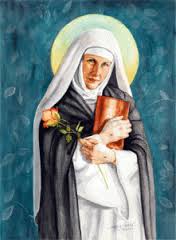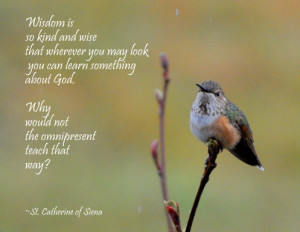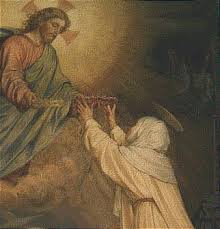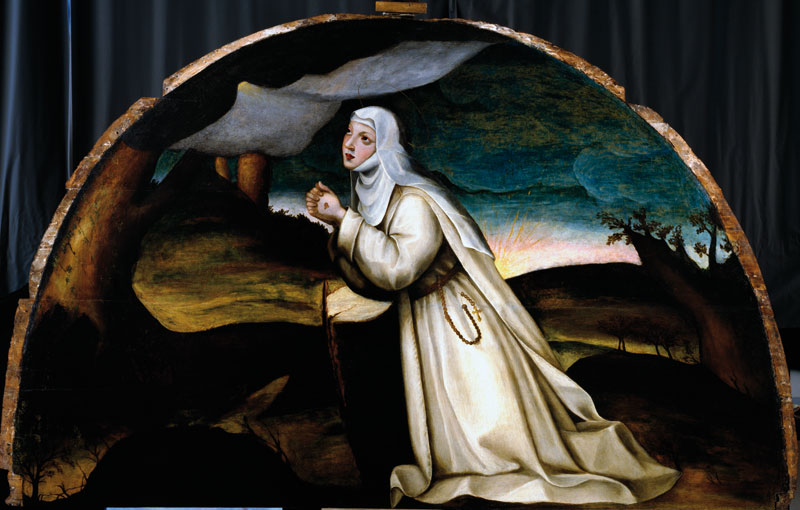
Summary: Saint Catherine of Siena
Mary O’Driscoll OP has lectured on St Catherine of Siena in many countries, finds messages for today in the great saint’s life and writings.
One of the characteristics of contemporary spirituality is a return to classical sources for light and nourishment on our own journey as Christians. In this short reflection I would like to share some thoughts on the spirituality which is offered to us by one of the greatest mystics in the Christian tradition, Catherine of Siena, for I believe strongly that she has much to say that is relevant for today’s Christians.
Remarkable Christian Woman
Catherine of Siena was a remarkable Christian woman. She stands out not only in her historical period, but also in succeeding centuries, as a colourful, strong, passionate and enthusiastic personality. She was a woman who had a tremendous zest for life and who put all of herself into whatever she was convinced about. One of her biographers describes her as someone who was always ‘at full stretch’, whether she was responding whole-heartedly to her loving God or reaching out compassionately to her needy neighbour.
Time of great change
Catherine Benincasa (to give her actual name) was born in Siena in Italy in 1347. The fourteenth century in which she lived bears many resemblances to our own twentieth century. In fact, our century is seen by many as “distant mirror” of Catherine’s century. (See for example, Barbara Tuchman, A Distant Mirror, Macmillan, 1978). Both periods are characterized by great cultural, economic, political, religious and social changes with all the insecurity, confusion and upheaval that go with such changes. Catherine, through her life and writings, was clearly able to speak to her contemporaries of the fourteenth century in relevant and helpful ways, so there is a good chance that she can speak to us too.
Doctor of the Church
 Another reason for seeking a suitable Christian spirituality for ourselves today from Catherine of Siena has to do with the fact that in our own century she has been named a doctor of the Church.
Another reason for seeking a suitable Christian spirituality for ourselves today from Catherine of Siena has to do with the fact that in our own century she has been named a doctor of the Church.
In 1970 Pope Paul VI, conferred this title on her and on Teresa of Avila. This was an extraordinary occurrence. The title, doctor of the church has been conferred on relatively few (34) christian theologians in the course of church history, and on no woman before 1970. The significance of this declaration is immense, for it places two women mystics among the major church theologians, thereby recognizing their ecclesial role as teachers whose doctrine is relevant for the whole church and for all time. By declaring in our time the laywoman, Catherine of Siena, a doctor of the church, Paul VI was surely recognizing not only that her theological teaching is authentic and therefore contributes to our understanding of revelation, but also that she has something worthwhile to say to our age.
Literary vitality
 Catherine’s spirituality was lived out day by day in her life, and she offers us its main dimensions in her writings, particularly in her mystical experience of God, and her own understanding of what the Christian life is about.(See Suzanne Noffke, The Dialogue, Paulist Press 1980). One of the attractions of Catherine’s writings is her style which is spontaneous, energetic and passionate. Her literary vitality comes in great measure from her superb use of imagery. She uses images in her efforts to communicate her inexpressible experience of the most profound realities, and hopes that these images will stimulate the dormant intuition of her readers opening up for them a deeper meaning of human and divine truths. Her images come from the ordinary things and experiences of her life:
Catherine’s spirituality was lived out day by day in her life, and she offers us its main dimensions in her writings, particularly in her mystical experience of God, and her own understanding of what the Christian life is about.(See Suzanne Noffke, The Dialogue, Paulist Press 1980). One of the attractions of Catherine’s writings is her style which is spontaneous, energetic and passionate. Her literary vitality comes in great measure from her superb use of imagery. She uses images in her efforts to communicate her inexpressible experience of the most profound realities, and hopes that these images will stimulate the dormant intuition of her readers opening up for them a deeper meaning of human and divine truths. Her images come from the ordinary things and experiences of her life:
*a fire eagerly consuming the wood thrown on it,
*light filtering through a narrow street,
*a tall tree laden with fruit,
*bridge across a river, the mirror in which she sees her own reflection,
* a vineyard, the vast ocean with its peaceful surface.
This last image is a favourite of Catherine’s. In one place in The Dialogue she prays:
“You, Eternal Trinity, are a deep sea. The more I enter you, the more I discover, and the more I discover, the more I seek you”.
Self-knowledge
The context in which Catherine develops her theology and spirituality is self-knowledge. This is very interesting. Her first theological question is therefore, not “Who is God?” but “Who am I?” This question, “who am I?” is a haunting question for people today. In our time, more and more people speak of an emptiness within themselves, a sense of meaninglessness in their lives. “Who am I?” or “What is the meaning of my life?” can at times become a terrifying, tormenting question. Most of us will have asked ourselves this question in one way or another, at one time or another in our lives. The times we question the meaning of life or our identity or worth are usually not the times when we feel everything is going well or when we are successful or feel good about ourselves, but rather when we have to cope with failure or sickness or loneliness or rejection or despair. In her writings Catherine of Siena shows that she is aware of such moments, and it is through them that she begins her quest for self-knowledge.
In seeking knowledge and understanding of ourselves, Catherine explains that we will never find these if we keep looking only at ourselves. Rather, in order to know who we are or what the meaning of our lives is, we need to go to the One who made us. Einstein declares, “If a person finds a satisfying answer to the question ‘what is the meaning of life?’ that person I would call religious”. Catherine of Siena would agree. In stating that we need to look at God in order to know who we are, she is not however offering an easy way out of the question but rather showing her appreciation of the fact that, although we can come quite far in understanding ourselves by looking at ourselves, we can never arrive at the deepest, richest self-knowledge without seeing ourselves through God’s eyes, or, as she puts it, without gazing at ourselves in the “gentle mirror” of God. Catherine’s God is always gentle just as the God Jesus tells us about in the gospels is gentle. The reason we can see ourselves in our gentle God is that we are made in the divine image.
Not afraid of the dark
The process or growing in self-knowledge is compared by Catherine to digging a well. If we want to make or uncover a well we need to dig through much soil, even stones at times, before we reach the running water. Likewise in coming to know ourselves, we come in touch with our own inadequacies, imperfections, failures, limitations. These are what Catherine calls “the soil of our poverty“. She encourages us not to be afraid to go down this well, that is, not to run away in fear or disgust from that part of ourselves which is dark, frail or imperfect. Rather, she encourages us to stay with it, for it reminds us of an important truth about ourselves, namely, that as created beings, we have to accept that limitations and inadequacies are built into our human condition. This however is not a depressing discovery; rather, in becoming aware of our failures and incompleteness, we become aware also of our need for God, the running water at the bottom of our well, and we begin to stretch out and reach down towards this bubbling source of life within us. We are like the deer that yearns for running streams (Ps.42), or like the dry, weary land that longs for water (Psalm 63). At the bottom of our well, at the centre of our being, therefore, where we best know who we are as limited human beings, we rejoice in God who is All, and it no longer matters (in fact it is an advantage) that we are small, frail, imperfect.
That is one part of the answer to the question, “who am I“? – the part that puts me in touch with the truth that I am a creature and not the creator (and in that sense, I am, in Catherine’s words, “the one who is not“). There is however another side to who I am, namely, that I am of tremendous worth and have extraordinary dignity. To do justice to Catherine of Siena’s teaching on self-knowledge, we need to reflect also on this.
God’s love
 When we look at ourselves in God’s “gentle mirror“, the first truth that we discover is that we are loved. Catherine never ceases to be amazed at the depth and extent of God’s love for us. This is expressed above all in Creation and Redemption. Explaining God’s creative love, she prays: “With indescribable love you looked at us within your very self, and you fell in love with us. So it was love that made you create us and give us being”. (Dialogue 13)
When we look at ourselves in God’s “gentle mirror“, the first truth that we discover is that we are loved. Catherine never ceases to be amazed at the depth and extent of God’s love for us. This is expressed above all in Creation and Redemption. Explaining God’s creative love, she prays: “With indescribable love you looked at us within your very self, and you fell in love with us. So it was love that made you create us and give us being”. (Dialogue 13)
There is no other reason for our existence except God’s love. Catherine pictures God addressing her as “my dearest daughter whom I love so very much”. God wants to tell each of us, too, of the extent and depth of divine love. If Catherine of Siena is amazed by God’s love in creating us, she is more staggered by the even greater manifestation of that love in the Incarnation. Trying to fathom God’s redemptive love, which comes to us through Jesus Christ, she asks: “Do you need your creature? It seems so to me, for you act as if you could not live without her. She runs away from you and you go looking for her. Why are you so mad?” (Dialogue 153)
Yes, in looking at myself in God, I can say with absolute certainty, “I am loved”. The knowledge and experience of being loved gives us the freedom to love others freely and sends us out into our world, as nothing else can, to share our love with others.
Beauty
Looking at ourselves in God, our “gentle mirror”, we also realize how beautiful we are. Here we are reminded of the statement in Ephesians: “you are God’s work of art” (Eph. 2:10). Catherine’s spirituality, more than that of many others, stresses the beauty of the human person. That beauty comes about first of all because we are made in the image of God who is “beauty beyond all beauty”. At the beginning of The Dialogue, Catherine receives the invitation: “Open your eye and gaze into me and you will see the dignity and beauty of human persons” (Dialogue 1). She would say that all the magnificent and breath-taking beauty which is disseminated in the natural world is surpassed by the beauty of the human person made in God’s image and redeemed by Jesus Christ. Some of us find it hard to believe in our own beauty; that may be because we are not looking into the gentle mirror that is God to know who and what we are. Others find it hard to see beauty in some people who do not appeal to them. Here the advice God gives to Catherine is relevant: when you see something you do not like in a person, “pluck the rose from the thorns” (Dialogue 100) Many people in our world today have no sense of their own beauty and dignity. Our task as christians is to try to bring them to a realization of who and what they are.
We see from our reflection that self-knowledge, in the sense in which Catherine uses the term, is not a morbid or depressing introspection. It is rather a knowledge of ourselves which we gain by gazing contemplatively at the gentle God who created us. “I am loved, I am beautiful”, we can all say with absolute conviction. This conviction is our best antidote to the materialism and sense of meaninglessness which have such a stranglehold on our twentieth century existence.

This article first appeared in Spirituality (July/August 1995), a publication of the Irish Dominicans.